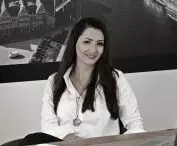In recent months, local SARP branches held elections for the new authorities for the 2024-2028 term [RESULTS]. We bring you up to date on the plans of the newly elected presidents of the Society of Polish Architects, and ask them about contemporary challenges facing architects. Today Natalia Balcerzak, president of the SARP Wybrzeże Branch, answered our questions.
SARP Wybrzeże Branch
Ola Kloc: What program of activities of the SARP branch do you envision for the near future? Are there any changes planned?
Natalia Balcerzak: When I took the helm of the Wybrzeże Branch, I was aware that I would have to face many difficult tasks. The most important, from the property owner's point of view, will be to raise funds and begin the renovation of our headquarters, i.e. the Golden Gate and St. George's Brotherhood Court. This activity was started by my predecessor (one of the three stages has been completed), and I am continuing it together with the Branch Board.
Another priority is to promote the work of our members. I have set myself the goal of organizing an exhibition of the works of my colleagues in the form of a photo-presentation in the entrance hall of our headquarters. The exhibition would function daily and would be refreshed once every six months.
Undoubtedly, the integration of the environment is also important — here, in addition to the integration of branch members, I mean integration with the professional self-government, that is, the Chamber of Architects. I will boast — we have already had three meetings with the Council of the Pomeranian District Chamber of Architects, and I am convinced that our cooperation will be fruitful. We also need to integrate with the regional and territorial government, as well as with the scientific community.
It seems to me that the biggest change in our branch is a woman in the position of President — this is the first time in history that the Coast Branch is managed by a female president. I hope and will do my best to make this term positively unique and groundbreaking.
Ola Kloc: What are the biggest challenges facing architects today?
Natalia Balcerzak: It seems to me that the biggest challenge is trying to convince our potential and future contractors of the important role an architect plays in the investment process. A majority of clients think that an architect is just a drafter of their ideas, and if we don't like such a division of roles, they break the contract with us and look for a new "drafter". At every step we have to emphasize how great our responsibility is — both civil and social.
Another challenge is remuneration for the work — there are no adequate tools in the form of regulations on fees for the execution of design documentation, and thus an "anything goes" operates. Investors who choose to work with a particular architect, regardless of cost, are a small percentage. The main thing that works is the price, and I would prefer it to be decided by the style in which the architect feels comfortable, or the volume.
I, for example, like small scale, i.e. single-family housing, small commercial buildings and historic buildings. I would like my potential client to choose my studio only because he likes my idea for his investment, not the price. The cost of doing design documentation should be equal, depending on the scope.
And finally, the challenge is to try to stop the misuse of the name of our profession. For many years, I have been observing a disturbing trend — an architect can be anyone... And a person who finished a weekend course in interior design, as well as a person who does nail styling, calling himself a "nail architect" — not to belittle these people, because every profession is necessary. However, I would prefer that people who do interior design (not to be confused with interior designers who graduated from the Academy of Fine Arts) title themselves designers or decorators, and let those who do housekeeping training be "housekeeping coordinators" or "housekeeping managers", but for goodness’ sake, not architects. As an architectural community, we should strive for a regulation that clearly defines architect as a profession — as is the case with other public trust professions.
Ola Kloc: How many members are there in the branch, and how much are the dues?
Natalia Balcerzak: We currently have 375 members — SARP Wybrzeże Branch is one of the larger branches in Poland, the membership fee is PLN 15 per month, for retired members the cost is half that. As you can see, the membership fee is rather symbolic.
Ola Kloc: What does SARP give to architects today? Why is it worth being a member of the Association?
Natalia Balcerzak: I have been a member of SARP longer than a member of IARP. This year I am celebrating fifteen years of membership in the Association, compared to thirteen years of membership in the Pomeranian District Chamber of Architects. In SARP, I have already been a member of the Branch Board, Vice President for External Affairs of the Branch, a member of the Branch Fellowship Court and Chairman of the SARP General Fellowship Court, and today I am President of the Branch — that is, I have actually come quite a long way, but with each successive function and each time I have taken away a huge lesson, met many excellent architects from all over Poland, and participated in fantastic events related to architecture and urban planning. To this day I remember the feeling when during a branch meeting I addressed a branch member and at the same time a lecturer at Gdansk University of Technology as "Mr.", and my interlocutor corrected me and asked me to call him "You", because in SARP we are all colleagues. A great feeling!
To the question of what SARP can give, one answer comes to mind — to paraphrase J.F. Kennedy — what can an architect give to SARP? The larger the community, the more it will be heard. Both in terms of laws, regulations at the national level, and locally, at the local government level. If something bothers us, if we disagree with something, let's get together in SARP and speak out about it, sign a joint petition and go with it to the authorities.
On average, 12-15% of members come to the branch's general meetings, which translates into 5-7% of people actively involved in the branch's activities. And if even 50% of the members come to the meeting and half of them are active, with such a composition we are able to organize three times more events than before.
For example, recently the office of the SARP Wybrzeże branch sent a request on my behalf to all our members asking them to participate in the design process for the renovation of the Golden Gate and St. George's Brotherhood Court. Since we need to carry out the renovation, and this requires the development of design documentation, and we theoretically have 375 architects in the branch, it seems natural to ask for their help to prepare the project at our own expense. What do you think — how many people volunteered to help? — 0 (I'm not counting myself, because I volunteered even before sending the request). And yet, it could also be a great opportunity for integration.
Besides, I consider it a distinction to include such a project in my portfolio. Therefore, I take this opportunity to address my fellow architects — I ask you to get involved in the activities of the branch, we have a beautiful headquarters (dare I say, one of the most beautiful in Poland) and with joint efforts we can restore its former glory. For this we need, among other things, a jointly prepared project.
So let's not ask what SARP can give us, but ask what we can give SARP. And we can give a lot.














